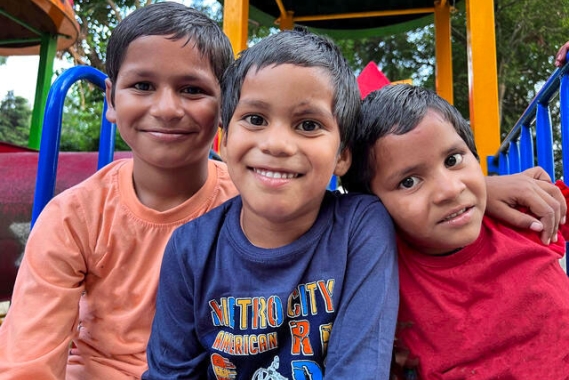Siblings find new home at SOS Children's Villages after life on the streets in India
When a mother died in a train accident close to a railway station in Lalkuan, India, it took police a while to identify her and find the three young children she had left behind.
The family lived in a makeshift home very close to the station. They survived on the meagre earnings of their mother and by picking through trash in search of recyclable pieces of plastic, metal, and glass to sell.
Neighbours pieced together the story of the family: the woman had been abandoned by her alcoholic partner and had come from another city to stay at the railway station with her children. The eldest son, Vipin*, was 7 years old, the middle child, a girl called Pinky* was 4, and the youngest boy was Raj*.
As there were no relatives to look after the children, the child welfare authority placed them under the care of an SOS Children’s Village in April 2021. The three children were in a state of shock. “They were unusually quiet and would not talk about themselves,” say their SOS Children’s Villages caregiver. “They would also stick together all the time. They didn’t feel safe inside a house as they were used to living on the street.”
Around 1.5 million children live on the streets in India, according to the Indian National Child protection chairperson Priyank Kanoongo. Some reasons why children find themselves on the streets include extreme poverty, abandonment, dysfunctional families, and violence in the home. Other factors are a lack of shelter, rural-urban migration, and displacement due to emergencies.

Around 1.5 million children live on the streets in India, according to the Indian National Child protection chairperson Priyank Kanoongo. Some reasons why children find themselves on the streets include extreme poverty, abandonment, dysfunctional families, and violence in the home. Other factors are a lack of shelter, rural-urban migration, and displacement due to emergencies.
The social exclusion of being homeless usually means a difficult future for children. Many are sexually exploited and abused, get into drugs, and never get beyond doing basic labour for sustenance.
Rehabilitating children who have lived on the streets requires specialized care. They have experienced the worst from adults and find it hard to accept anyone as a parental figure, explains Samiha Fazilat, an educator at the SOS Children’s Village. “The children had never experienced much care or adult supervision and had to be taught everything from how to use the toilet to how to eat communally. Slowly with the care and attention, these children have adjusted to their new lives in the house,” says Ms. Fazilat.
Anjali Kumari, an SOS Village counsellor, worked steadily with the children to foster in them a sense of trust and security. “As trust developed, the eldest sibling shared details of their life with their village counsellor telling her about the hard life they had with their mother on the street,” she says.
Until arriving at the SOS Children’s Village, the siblings had never been to school a day in their life. To prepare them, the SOS Village staff had to take time. A development plan was put in place and they were given remedial classes. The children had to accept that all their time was not to be spent playing or being on the street. They also had to be taught how to speak politely with the village co-workers, caregivers, and other children who lived with them.
After a while, Vipin, who learned fast, was sent to first grade while the younger two were sent to kindergarten, even though they were older than most other children in their grades.
“I love going to school and I love playing football,” says Vipin. “When I used to go out to gather trash, I had a few friends who would play something similar to football with plastic bottles. Now I have a football court and sometimes I even bring a football home to play with Raj and Pinky.”
“My best days are when the whole family is at home during holidays and then if someone rings the bell, Raj starts dancing. It’s so funny the whole house starts laughing and then whomever the visitor is, starts laughing, and then we ring the bell a few more times so that Raj can keep dancing and we can laugh some more,” he says.
Names have been changed to protect children's privacy*
